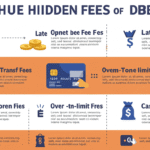As student loan payments are poised to rise dramatically, borrowers across the nation face a new financial landscape that demands attention and preparedness. Understanding this shift is critical for effective financial planning. Here’s what borrowers need to know about the impending changes in student loan payments.
### 1. Reasons for Rising Payments
The recent pause on federal student loan payments, initiated during the COVID-19 pandemic, is set to end. This moratorium provided a temporary reprieve for millions of borrowers who were unable to make their payments due to financial hardships. With the end of this pause, borrowers must brace themselves for the return of regular payments, which can significantly impact personal budgets and financial health.
### 2. Loan Types Affected
Most federal student loans are impacted by these changes, including Direct Subsidized and Unsubsidized Loans, PLUS Loans, and Consolidation Loans. Private student loans may also see shifts in payment terms, although they depend on individual lending agreements. Borrowers should review their loan portfolios to understand which loans are affected and what specific changes may apply.
### 3. Expected Increase in Payments
Payments are anticipated to rise due to accumulated interest during the deferment period. For many borrowers, this could mean higher monthly payments when they resume. According to estimates, the average monthly payment may increase by 20% or more, depending on the loan amount and interest rates. This could create considerable financial strain, especially for borrowers who have not budgeted accordingly.
### 4. Income-Driven Repayment Plans
To mitigate financial burden during the payment resurgence, borrowers may want to explore income-driven repayment (IDR) plans. These plans calculate monthly payments based on income and family size, ensuring that borrowers pay an affordable amount relative to their financial situation. Some IDR plans can even lead to loan forgiveness after a set period, typically 20 to 25 years.
Borrowers should apply for these plans as soon as possible to take advantage of potential lower monthly payments. It is also important to stay updated as the government may implement reforms to IDR plans, potentially making these options even more beneficial.
### 5. The Importance of Budgeting
Given the eminent payment increase, budgeting becomes a crucial skill for borrowers. A comprehensive budget should include all necessary expenses, such as rent, utilities, groceries, and now, student loan payments. Borrowers should also factor in an emergency fund to handle any unforeseen expenses that may arise as they adjust to repayment.
Utilizing budgeting tools or apps can simplify the process, allowing borrowers to track spending habits and find areas to cut costs. Proactive financial management can make a significant difference in coping with increased loan obligations.
### 6. Exploring Refinancing Options
For borrowers looking for more manageable payments, refinancing may be a viable solution. Refinancing involves consolidating multiple loans into one at a potentially lower interest rate. This option can reduce the total monthly payment and overall interest paid over time.
However, borrowers must consider the trade-offs of refinancing, particularly that federal loan benefits (like IDR plans and potential forgiveness) may be lost when switching to a private lender. Careful consideration and financial advice can help in making an informed decision about refinancing.
### 7. Understanding Interest Rates
Interest rates will play a major role in the total cost of student loans. Current federal loan interest rates may fluctuate, impacting what borrowers will owe upon resuming payments. Keeping informed about these rates can help borrowers understand how much their loans will cost in total and anticipate future payment amounts.
Generally, interest for federal loans is fixed, while private loan interest may vary depending on market conditions and the borrower’s credit score. Checking these rates periodically is recommended to ensure borrowers are not paying more than necessary.
### 8. Engaging With Loan Servicers
Effective communication with loan servicers is vital as payments resume. Borrowers should regularly check their accounts for updates, verify payment amounts, and ensure they understand any existing repayment options. Loan servicers can provide valuable insights into managing debt and exploring available relief options.
Borrowers should also be aware of the timeline on which payments are due and how grace periods may apply as repayments restart. Failure to communicate with servicers can lead to missed payments, late fees, and a potential negative impact on credit scores.
### 9. Assistance Programs and Resources
The government and various organizations offer assistance programs designed to help student loan borrowers. These may include financial counseling, employed programs that may help prevent loan defaults, and resources to improve financial literacy.
Organizations like the National Foundation for Credit Counseling (NFCC) and U.S. Department of Education provide valuable tools and information for managing debts and navigating repayment processes. Borrowers should take advantage of these resources to enhance understanding and effectively manage their financial obligations.
### 10. The Bigger Picture
Rising student loan payments align with a broader national conversation about student debt and its implications for the economy. Many borrowers are voicing concerns about the long-term effects of debt on purchasing power, home ownership, and overall financial stability. Advocacy for policy changes and student debt relief remains a pressing issue.
Engaging in this national dialogue can empower borrowers and their advocates to influence changes in legislation that may affect future borrowers and college students. Whether through social media, voting, or community engagement, using one’s voice holds the potential to impact student debt policy positively.
### 11. Staying Informed
Lastly, borrowers must stay informed about legislative changes regarding student loans as they evolve. Policy shifts, repayment options, interest rates, and potential forgiveness programs can change. Regularly checking credible news sources, following government updates, and engaging with community financial advisors will enhance borrowers’ financial literacy and preparedness.
By understanding the implications of rising student loan payments and taking proactive measures, borrowers can navigate this tumultuous transition more effectively. Adequate planning, open communication with loan servicers, and utilizing available resources will be crucial in managing this new chapter in student loan repayment.




